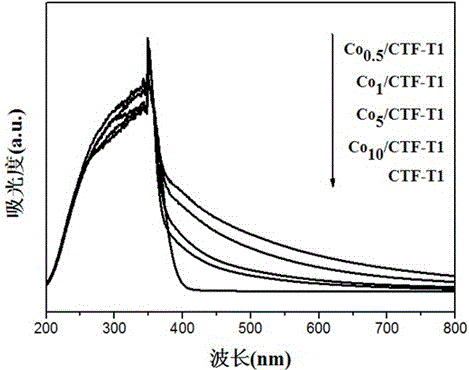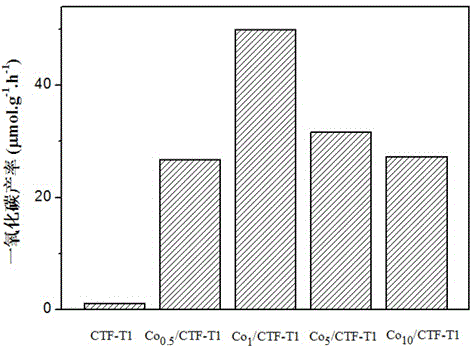Covalent organic polymer based visible-light photocatalyst capable of efficiently reducing CO2
A covalent organic, photocatalyst technology, applied in the field of photocatalysis, can solve the problems of limiting the application of CTF-T1, high recombination rate of photogenerated carriers, and narrow photoresponse range, and achieve high practical value and application prospects, process process Simple and easy to control, the effect of great application prospects
- Summary
- Abstract
- Description
- Claims
- Application Information
AI Technical Summary
Problems solved by technology
Method used
Image
Examples
Embodiment 1
[0020] At 0°C, add 40 mL of trifluoromethanesulfonic acid into 5.12 g of terephthalonitrile, stir until the terephthalonitrile is completely dissolved, change the oil bath and raise the temperature to 30°C, and keep it for 3 days. The resulting precipitate was rinsed and filtered with 160 mL of dichloromethane, washed with ammonia water, then added with 200 mL of ammonia water and stirred for 12 h, washed with water until neutral, and then centrifuged with methanol once to obtain a solid precipitate; Reflux for 24 h under the same conditions, and then reflux with dichloromethane for 24 h at 70 °C, collect the solid, and dry it in vacuum at 80 °C for 12 h to obtain the covalent organic polymer CTF-T1 based on the triazine structure.
Embodiment 2
[0022] Mix and dissolve 0.1 mL cobalt chloride solution (10 mg / mL concentration) and 0.2 g CTF-T1 in 10 mL distilled water. After ultrasonication for 40 min, heat and stir in a water bath at 80 °C until the water is evaporated to dryness. In a Furnace, calcined at 250°C for 1 h in an air atmosphere to obtain a solid sample; after fully grinding the calcined solid sample, reflux it with methanol at 90°C for 12 h, and dry the obtained solid at 60°C for 12 h , that is, cobalt-doped covalent organic polymer visible-light photocatalyst Co 0.5 / CTF-T1.
Embodiment 3
[0024] Mix and dissolve 0.2 mL cobalt chloride solution (10 mg / mL concentration) and 0.2 g CTF-T1 in 10 mL distilled water. After ultrasonication for 40 min, heat and stir in a water bath at 80 °C until the water evaporates to dryness. In a Furnace, calcined at 250°C for 1 h in an air atmosphere to obtain a solid sample; after fully grinding the calcined solid sample, reflux it with methanol at 90°C for 12 h, and dry the obtained solid at 60°C for 12 h , that is, cobalt-doped covalent organic polymer visible-light photocatalyst Co 1 / CTF-T1.
PUM
| Property | Measurement | Unit |
|---|---|---|
| concentration | aaaaa | aaaaa |
Abstract
Description
Claims
Application Information
 Login to View More
Login to View More - R&D
- Intellectual Property
- Life Sciences
- Materials
- Tech Scout
- Unparalleled Data Quality
- Higher Quality Content
- 60% Fewer Hallucinations
Browse by: Latest US Patents, China's latest patents, Technical Efficacy Thesaurus, Application Domain, Technology Topic, Popular Technical Reports.
© 2025 PatSnap. All rights reserved.Legal|Privacy policy|Modern Slavery Act Transparency Statement|Sitemap|About US| Contact US: help@patsnap.com



